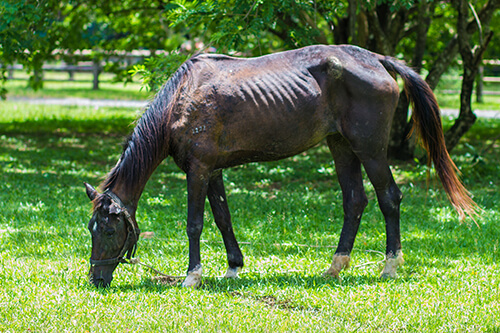From Skinny Horse to Healthy Horse
May 25, 2020

Restoring the health of a neglected or starved horse is definitely a labor of love. There’s no quick fix — you’ve got to introduce feed slowly to allow the microbial populations in the gut an opportunity to rebuild — so, you need both patience and a plan.
We’ll let you work on the patience, but here are some suggestions for an effective nutritional plan:
Start with forage
Senior feed (Co-op Winner’s Cup Golden Years 1300 [#323]) works well because it contains higher levels of soluble fiber and fat and controlled levels of starch. Excess starch can cause digestive upset in recovering horses. Senior feeds are also more highly digestible and easily chewed by horses with dental challenges.
For more information on equine nutrition visit your local Co-op!
We’ll let you work on the patience, but here are some suggestions for an effective nutritional plan:
Start with forage
- Begin by feeding small, frequent meals of good, quality grass or alfalfa hay. Leafy alfalfa is ideal. A forage analysis is a useful tool to assess forage quality. At a minimum, the hay should be free of mold, dust, and weeds.
- Offer the hay at a rate of 1 percent of body weight per day (approximately 10 pounds per day for a 1000-pound horse), dividing the total amount over four to five small meals each day. Gradually increase the amount of hay provided so that the horse has unlimited access to hay by two weeks of feeding.
- At three weeks, you can begin to gradually introduce a grain mix into the diet. Start by feeding one to two pounds per day for two to four days. Gradually increase the amount of grain mix fed by one pound every other day until a total of 1 percent of body weight is being fed (10 pounds per day for a 1000-pound horse). The grain mix should be divided into at least two to three (ideally, four to five) small meals throughout the day.
Senior feed (Co-op Winner’s Cup Golden Years 1300 [#323]) works well because it contains higher levels of soluble fiber and fat and controlled levels of starch. Excess starch can cause digestive upset in recovering horses. Senior feeds are also more highly digestible and easily chewed by horses with dental challenges.
- A pelleted feed like Co-op’s Winner’s Cup Advantage 1400 [#321] also works well because of its higher level of protein (14 percent) and increased digestibility.
- Fresh clean water should be available at all times. Also, plain white salt should be offered at one to two ounces per day and gradually increased to free-choice access by two weeks of feeding.
- In about two weeks, you can expect to start seeing increased levels of alertness and activity.
- In about four weeks, you should begin to see increases in weight gain.
- Full recovery may take up to six months.
- The lower the horse’s body condition, the longer it will take to recover.
- Quality of feedstuffs plays an important role in how quickly a horse recovers.
- Minimizing stress facilitates the recovery process. If the horse is comfortable being separated from other horses, this will allow you to better monitor intake. However, if the horse does not like to be alone, find a single buddy for company. Hold off introducing into the herd until after the starved horse has regained a sufficient amount of weight for defense and protection.
- If brought back to feed too quickly, there is an increased risk of colic, laminitis, diarrhea, and other metabolic disturbances.
- A condition called refeeding syndrome can occur if the horse is fed too many calories too quickly. This can lead to heart, kidney, or respiratory failure and is caused by the sudden introduction of high levels of carbohydrates and nutrients in the diet.
For more information on equine nutrition visit your local Co-op!